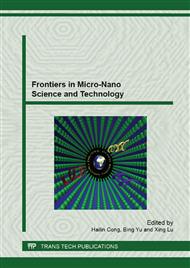[1]
Crabb, W. D., Shetty, J. K. (1999). Commodity scale production of sugars from starches. Curr. Opin. Microbiol., 2: 252–256.
DOI: 10.1016/s1369-5274(99)80044-7
Google Scholar
[2]
Crabb, W.D. and Mitchinson, C. 1997. Enzymes involved in the processing of starch to sugars . BTECH. 15: 349-352.
DOI: 10.1016/s0167-7799(97)01082-2
Google Scholar
[3]
Haki, G. D. and Rakshit, S. K. (2003).
Google Scholar
[4]
Ikram-ul-Haq, Ashraf H, Iqbal J and Qadeer MA (2003) Production of alpha amylase by Bacillus licheniformis using an economical medium. Bioresource Technology, 87: 57–61.
DOI: 10.1016/s0960-8524(02)00198-0
Google Scholar
[5]
Review. Bioresource Technology, 89: 17-34.
Google Scholar
[6]
Masahiro,S., Takashi,E. andRitsuka, O. 1997. Improvement of detergency oflaundry bleach compositions and bleaching method without color darkening. Microbia., 5(25): 1010-1020.
Google Scholar
[7]
Appleyard, H. (1953). Enzyme action in desizing. Dyer., 109: 685-687.
Google Scholar
[8]
Onzales . M. A 1997. Laundary detergent bar composition with bleach system stabilized by enzymes . Av. Appl., 9: 110-115.
Google Scholar
[9]
Pandey, A., Nigam, P., Soccol, C. R., Soccol, V. T., Singh, D. and Mohan, R. (2000). Advances in microbial amylases. Biotechnol. Appl. Biochem., 31: 135–152.
DOI: 10.1042/ba19990073
Google Scholar
[10]
. Allan, S., Torbenvedel, B. and Henrik, B. F. (1997). Recombinant alpha amylase mutants and their use in textile desizing, starch liquefaction and washing. PTC. Int. Appl., 12(5): 205-210.
Google Scholar
[11]
Allan., S., Henrik., B. F and torbendevel, B 1996. A method of desizing alpha mutants , with predetermined properties alpha amylase variants and detergents containing the variants Process B iochenm., 31(5): 110-210.
Google Scholar
[12]
Goyal,S. G and Khandeparkar,V. G 1978 Amylase from Bacillus subtilis159 for desizing . Indian journal. Text. Res.
Google Scholar
[13]
Iqbal. j. Yousaf,M. Chaudry.M. Y and Hamid, M. 1997. Desizing enzyme fromBacillus subtilis234. Pak.J. Sci., 49(1&2): 1-3.
Google Scholar
[14]
Julicher,W. 1952EnzymicDesizing of fabrics . Melliand. Textilber., 33: 511-516.
Google Scholar
[15]
Abate, C.M., Castro, G.R., Sineriz, F., Callieri, D. (1999). Production of amylolytic enzymes by Bacillus emyloliquefaciens in pure culture and in co-culture with Zymomonasmobilis. Biotechnology, Letters., 21 (3): 249-252.
Google Scholar
[16]
Adinarayana K, Kugen, P. andSuren S. (2005). Amylase production in solid state fermentation by the thermophilic fungus Thermomyceslanuginosus. J. Biosci. Bioeng. 100 2): 168-171.
Google Scholar
[17]
Bernier, R., Kopp, M., Trakas, B., and Stutzenberger, F. (2008). Production of extracellular enzymes by Thermomonosporacurvata during growth on protein-extracted lucernefibres. Journal of Applied Microbiology, 65(5): 411 – 418.
DOI: 10.1111/j.1365-2672.1988.tb01910.x
Google Scholar
[18]
Cheng-Hsiung Chang and Shang-Shyng Yang (2009). Thermo-tolerant hosphatesolubilizing Microbes for multi-functional biofertilizer preparation. Bioresource Technology(100) 1648–1658.
DOI: 10.1016/j.biortech.2008.09.009
Google Scholar
[19]
Haq, I., Ashraf, H., Qadeer, M. A., Javed, I. (2005). Pearl millet, a source of alpha amylase production by Bacillus licheniformis. Biores. Technol., 96: 1201–1204.
DOI: 10.1016/j.biortech.2004.09.012
Google Scholar
[20]
Van Der MarrelMJEC. Van Der VeenB, UitedhaangJCM, LeehiusH, Dijkhuizen L 2002. Properties and applications of staech converting enzymes of Alpha amylase family. J. Biotechnol, 94: 137-155.
DOI: 10.1016/s0168-1656(01)00407-2
Google Scholar
[21]
Peixoto, S. C., Jorge, J. A., Terenzi, H. F., DeLourdes, M. and Polizeli, T. M. (2003). Rhizopusmicrosporus var. rhizopodiformis: a thermotolerant fungus with potential for production of thermostable amylases. Int. Microbiol. 6: 269-273.
DOI: 10.1007/s10123-003-0140-1
Google Scholar
[22]
Poonam, N. and Dalel, S. (1995). Enzyme and microbial systems involved in starch processing. Enzyme Microb. Technol. 17: 770-778.
DOI: 10.1016/0141-0229(94)00003-a
Google Scholar
[23]
Kakumanu, P., Wilhelm, H, T,., Ryohei,O., Ceser,B. A and Soroh,R. 1997. Dingy fabric cleanup with amylase in detergent compositions P.C.T. Int Appl. 21(5): 333-340.
Google Scholar


